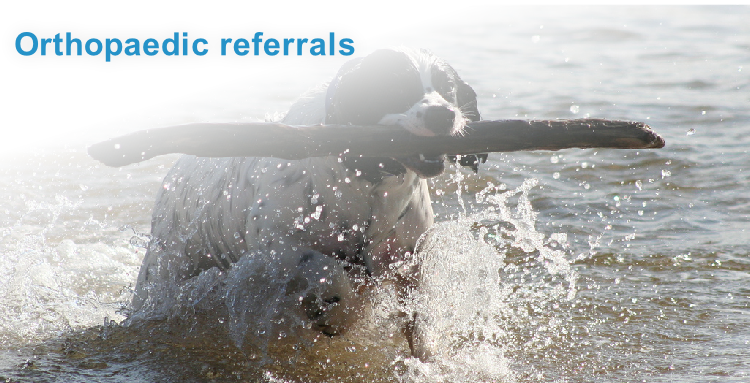
otherapy when it is unable to fully weight bear on its limbs especially if recovery appears to be protracted.
The following guidance is most likely familiar reading for most veterinary surgeons, however it may be useful to have it convenient for reference when considering referral of orthopaedic cases. These notes are guidance on the likely common cases and obviously the less common causes have to be considered.
Foreleg lameness in young, large breed dogs (labs, Retrievers, Rottweillers, GSD, giant breeds)
The most common site will be at the elbow with conditions such as fragmented coronoid process (FCP) and osteochrondrosis of the medial humeral condyle, elbow dysplasia and ununited anconeal process (UAP). The most useful radiograph is a flexed lateral view in which the anconeus is visible. AP view is also useful. FCP and osteochrondrosis are very difficult to diagnosis on radiograph in the early stages and some cases have few visible radiographic changes other than subtrochlear sclerosis. Hence in a young large dog with elbow pain (particularly on supination and flexion/extension) which is persisting for more than a few weeks after rest consider arthrotomy or better is arthroscopy for a diagnosis +/- treatment. This is best done early ie 6-8 months old.
A diagnosis of UAP can only be made after 20 weeks old as the anconeus does not normally fuse until this time. After 25 weeks the diagnosis is definite, common in GSD, often bilateral.
Shoulder pain can often be mistaken for elbow pain, because when the shoulder is extended the elbow extends also and it can be very difficult to distinguish between shoulder and elbow pain particularly in large active young dog. Hence if nothing is seen radiographically at the shoulder consider the elbow.
Shoulder OCD is seen in large and giant dogs esp Great Danes, and can be treated arthroscopically, with usually a good prognosis after surgery.
Foreleg lameness in adult dogs
The most common site will still be the elbow joint with possible DJD secondary to a FCP lesion which may have gone undetected in the young dog. Arthroscopic examination after radiographs gives the best method of diagnosis.
Shoulder instability is a common frequently under recognised condition affecting particularly very active middle aged, medium to large breeds and is as a result of injury to the gleno humeral collateral ligaments, supraspinatous and bicipital tendons. This condition can be diagnosed on arthroscopy and treated by arthroscopically placed suture/ suture anchor repair of the injured gleno humeral ligaments followed by a period of physiotherapy. It is similar to rotator cuff instability in human tennis players.
Hindleg lameness in young, large breed dogs (labs, Retrievers, Rottweillers, GSD, giant breeds)
The most common cause will be hip dysplasia with cases presenting from 6-9 months usually. Standard VD view usually gives a diagnosis and a laxity in the hip (ortolania sign) may be felt. Without surgery many cases will resolve at around 12 months old due to fibrosis and stabilisation of the subluxation however DJD and significant remodelling of the femoral neck and acetabulum will occur leading to DJD related pain later which cannot be reversed. If instead, cases are selected early and have surgery such as TPO to rotate the acetabulum and increase femoral head coverage whilst the dog is still growing (ie 5-9 months old ideally) DJD development can be significantly reduced or avoided. If surgery is performed at over 1 year old the outcome is not as good. Once DJD is present the surgery is not recommended.
If cases are diagnosed very early- 15-20 weeks old then Juvenile Pubic Symphysidesis (JPS) can be performed. This surgery is an excellent method as it can treat both hips simultaneously and is a minor surgical procedure, however it is most likely only effective if carried out before 20 weeks old.
Consider medial /lateral patellar luxation in some large breeds with straight hind legs eg Japanese Akitas or in association with hip dysplasia.
Osteochrondrosis of the femoral condyle and hock are less common causes is this group.
Avulsion of the origin of the cranial cruciate ligament may occur and mimics ACL rupture however crepitus may be felt in the stifle.
Hindleg lameness in young, small breed dogs (JRT, Yorkshire terriers, toy breeds)
The most common cause is patellar luxation. Usually it is medial luxation and either the patella can be luxated medially easily (grade 1-3) or else it is permanently fixed (grade 4). The dog often skips with the leg held up every few steps or may frequently extend in out backwards to help relocate the patella. Patellar luxation is often found incidentally at first vaccination although we tend only to operate on those who are clinically lame and all grade 4 cases. Most cases require tibial transposition. Failure to carry out a transposition and correct the quadriceps-patellar-tibial alignment is the most common cause of failure or recurrence.
Perthes disease of the hip causes avascular necrosis and acute pain. The only treatment option is femoral head and neck excision. This is best performed with an oscillating saw and not a gigi wire as the neck must also be removed. Leaving a spur on the neck will result in continued pain and require repeat surgery to remove.
Hip dysplasia can also occur in these small breeds
Advice to referring Veterinary Surgeon on case selection


| elbow arthroscopy key hole surgery dog ireland |
| elbow dysplasia |
| vet-arthroscopy-shoulder ocd-dog |
| shoulder arthroscopy dog- ligament injury |
| stifle arthroscopy dogs |
| hip arthroscopy dog |
| spinal xray myelogram |
| GSDA A stamp |
| elbow score |
| hip score |
| hip score guide for owners |
| directions |
| site map |